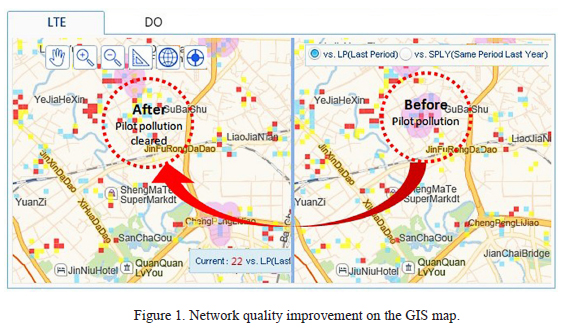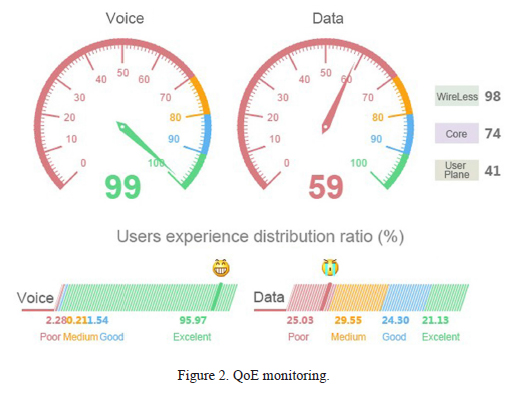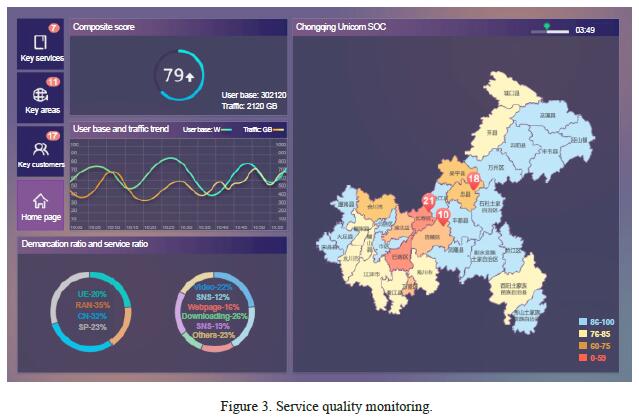Transformation from NOC to SOC
The massive use of mobile broadband services and associated applications has changed the way we work and live. The services used by customers today have gone beyond the legacy telecom domain. This creates blind spots in managing services end to end at the customer care and network operations center (NOC). Network operators are also facing revenue erosion from the competition of OTT. This further creates pressure on operators to differentiate themselves from their rivals by boosting customer experience on services and minimize operational costs. The way to address these challenges is to establish a service operations center (SOC) and transform from network-centric operations to service and customer centric operations. This article describes ZTE’s vision, best practices and solutions in supporting NOC to SOC transformation.
To address customer experience management (CEM), the first step is to understand touch points along the customer journey. A typical customer journey includes five stages: initial brand awareness, evaluation of the service offered, joining the network, use and care. If a consumer has a poor experience during any of these touch points, the customer may churn from the operator. By analyzing micro segmented customer groups and understanding customer behaviors at various touch points, we are able to capture and prioritize opportunities which please the customer. We can also understand negative customer experiences which need timely remedy action and proactive care.
The customer journey sets the framework for ZTE to work with the operator in identifying drivers for improving customer experience and implementing CEM use cases for customer retention, lifetime value maximization as well as advocacy of new products for boosting ARPU.
For transforming to customer-focused operations, SOC is a key enabler of this CEM journey providing the most important operational capabilities. However there are practical challenges for such a transformation. One of the challenges is that the benefits for NOC to SOC transformation are hard to quantify. In practice, implementing NOC to SOC transformation always starts with future vision alignment with CXOs so as to gain executive sponsorship from the operator. Quite often, we start with proof of concept with demonstrated achievements before fully rolling out such a transformation.
Another challenge is that there is no industry standard to follow. To address this issue, ZTE has designed a CEM transformation blueprint which can be referenced at the design stage. To have a clear view from the current mood of operation (CMO) to future mood of operation (FMO), ZTE uses the TM Forum’s CEM maturity framework for baselining the AS-IS state and defines the FMO in line with an operator’s budget and priority. The CEM maturity framework consists of six dimensions in strategy, organization, people, process, metrics and tools as well as five levels of maturities. This maturity model provides a common platform to work with operators in prioritizing a phased approach for such a transformation.
NOC to SOC transformation is an innovative approach enabling the operational organization to monitor end-to-end services and take timely remedy actions based on service impact and customer experience. ZTE promotes a partnership model to work with operators in identifying and prioritizing CEM drives and use cases, and designing architecture changes in terms of future organization and process, which is in line with ZTE’s blue print and big data VMAX solution. ZTE also emphasizes on joint governance to manage the change, which is critical to ensure the success and acceptance of transformation results.
ZTE has developed a SOC platform based on the big data solution that leverages its strength in network optimization, big data analytics and subscriber segmentation in QoE management. The following software packages are examples of ZTE’s big data solution for CEM and SQM of MBB services.
Statistics indicate that most customer dissatisfaction in the MBB era is routed to network quality issues that are linked to network optimization. With ZTE’s CEM solution, a significant number of optimization parameters can be automated in a visualized format in color code for its level of degradation on the GIS map through daily system calculation. The same are displayed in tabular format with direct results of root cause analysis along with expert suggestions. This significantly reduces the efforts and time in identifying optimization issues. With slicing and filtering functions of the raster map for network coverage, network quality can be easily monitored for designated areas such as motorway and central business districts (CBDs). By analyzing MR/CDT data, the system can discover network coverage holes and high-traffic areas in near real time. It can also precisely locate coverage problems in supporting the decision-making process for adding additional RAN sites while taking into account the business impact and return for investment. Moreover, after new RAN sites are built, the improvement can be compared with a historical view on the GIS map (Fig. 1).

The call center automation solution supports a call center agent to initiate a query on service quality degradation over the past 30 days for a specific customer in terms of voice and data services. It also provides intelligent fault demarcation and localization. With this solution in place, the customer contact center can enhance the first call resolution rate for MBB services and assure customer satisfaction by timely initiating remedy action and proactive care.
The QoE monitoring provides the possibility to monitor and evaluate service quality degradation over the past 30 days for a configurable customer group in designated geographical areas. The QoE solution can be integrated with customer complaints management solutions from CRM tools used by a customer contact center so that a complete view of subscriber experience is correlated to true network problems measured by the QoE monitoring system (Fig. 2).

In order to maximize customer lifetime value, there is a need to maximize the lifetime value of existing customers and enhance their loyalty. The churn prevention solution and micro segmentation of targeted subscriber groups can predict the churner with its root causes. The solution is also built with a retention model that provides the best time with predefined initiatives to retain customers in the network.
The near real-time service quality monitoring solution provides a GIS-based view of respective and combined voice and data service quality monitoring, and also a mechanism to monitor service degradation for targeted services and GIS areas(Fig.3). The solution analyzes problem demarcation and root causes in terms of service accessibility, retainability and integrity. The root causes are directly analyzed and summarized for corrective actions. The SQM is correlated with NOC umbrella systems with extended visibility and manageability that is not available from the end-to-end MBB service perspective in NOC today.

The knowledge of most popular services and applications enables network operators to know better customer consumption habits and service preferences. Therefore, operators can further tap into customer potentials for consumption.
ZTE’s insight reporting solution provides unified reporting with an aligned view between the customer-oriented organization and network-oriented organization. The data is gathered from not only the OSS domain but sometime even the BSS domain. Various insights can be generated in supporting agile service design, customer lifetime value maximization and network quality enhancement. The system can be integrated to the campaign management engine for launching and monitoring the effectiveness of service campaigns. Insights reports such as user behavior insight, terminal performance usage, traffic insights and value grid insights are within ZTE’s CEM solution library. More reports can be generated upon the joint identification at the CEM realization phase.
NOC to SOC transformation can be a challenge task. ZTE provides consulting services to operators at the initial design stage. Through the transformation from NOC to SOC, cluster and value based network operations can be implemented. SOC is measured against the key business objectives (KBI) and key quality indexes (KQI) while NOC is measured against key performance indicators (KPI). By leveraging KBI and KQI library from ZTE, operators can benefit the learning from ZTE for its own customization. And meanwhile, ZTE has readymade functional organization blueprint in assisting operators to design their target SOC organizations. ZTE also has a set of process blueprints that can be used for customization. ZTE big data team can design and implement the solution based on the functional requirements defined at the consulting stage. Finally ZTE service team can run and operate the overall solution before fully transferring to operators through enabling programs.
Outlook of NOC to SOC Transformation
Mobile operators are further diversifying and transforming into digital communication service providers. This strategic shift is supported by latest SDN, NFV, and 5G wireless technologies. This is a disruptive technology evolution from the perspective of network architecture and OSS/BSS. However, having the capability to maintain customer-oriented services, measuring SLA for targeted network slices and providing user experience on demand are still essential in offering services in the era of digital economy.
Due to the complexity of services modeling for technology prior to 4G, SOC is a complementary function to NOC. With the advent of SDN and NFV, future networks will be managed by real time inventory, orchestrated fulfillment and assurance. Our vision is that NOC and SOC will be converged into one unified MICT operation centre of the future namely OpCF. Today, ZTE’s big data solution has laid down a solid foundation for such a migration. It will be an integral part of the future real-time orchestrated service and QoE assurance solutions.
